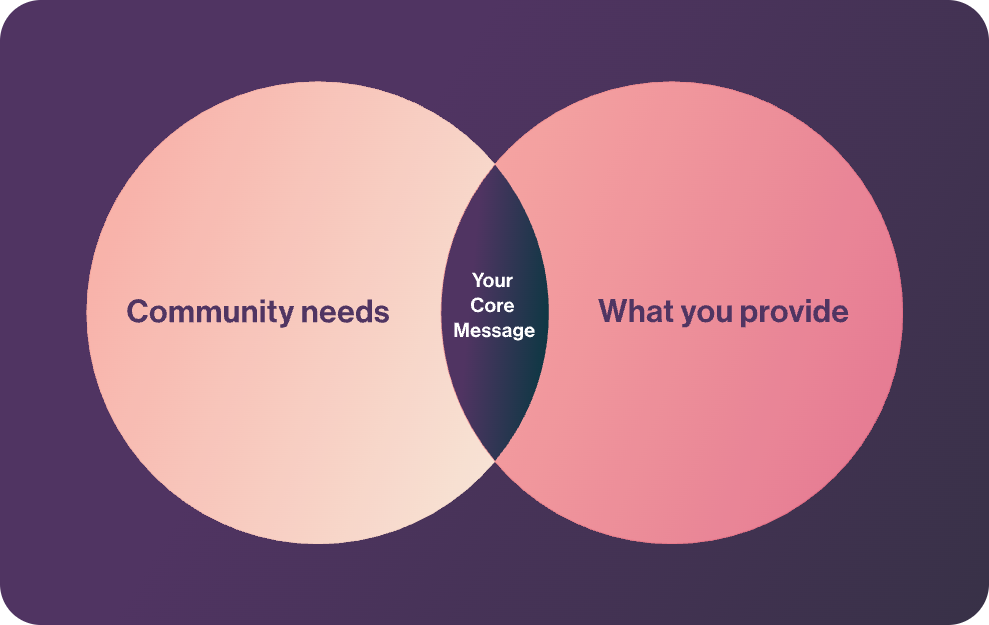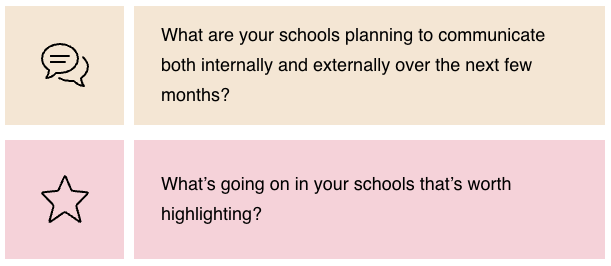Introduction
Think of all the tools private sector marketers have at their disposal. There’s fancy graphic design software, platforms for running targeted ads, software for tracking leads that could result in future sales. But the biggest tool of the trade just so happens to be something you (and every school administrator) already have: the human brain. Stick with me for a second—we’re about to get lowercase-m meta.
It’s all in your head
A lot of folks think about marketing or communications more generally as a skillset to acquire and cultivate. Whether it’s learning to write better ad copy or becoming a better photographer, it can be easy to focus on the external knowledge that shows up on a resume. But here’s a secret: you don’t need an MBA to be a good marketer. That’s because it’s not about the skillset—it’s about the mindset.
We’re talking about an entire frame of reference for viewing the world. In marketing, the brand (your school district) is the center of the universe. It’s what you have to study and understand intimately first and foremost. Then there’s your audience—who are you trying to reach or interact with? What are their wants and needs? The sweet spot is the space where what your brand uniquely offers and what your audience needs overlaps. That’s your selling point.

Once you’re in a marketing mindset, everyday interactions take on much greater significance. That’s because each touchpoint is an opportunity to market: to influence how people think or feel about your brand.
The sweet spot is the space where what your brand uniquely offers and what your audience needs overlaps. That’s your selling point.”
The good news is, much as marketing skills can be learned, a marketing mindset can be adopted. You can start to change how you approach your school community today if you’re willing to shift your thinking around what marketing is and how it can work for you. That’s good news, because the biggest roadblocks for many school leaders are the mental barriers that hold back creativity and exploration.
Don’t hesitate to brag
A good personality trait for any superintendent to have is humility—nobody is doubting that. However, there are some downsides to being humble about your schools.
We’ve encountered school administrators who, when asked, will excitedly explain all of the great things happening in the classrooms and in extracurricular activities. But when we go to their website or their social media accounts, these great things aren’t exactly leaping off the page. Sure, the students and teachers involved know, and hopefully the parents. But the wider school community often gets left in the dark.
This isn’t intentional, per se. Nobody is embarrassed by success or trying to diminish accomplishment. But there can be a sense of hesitation when it comes to trumpeting good news. Whether it’s out of concern that too many updates might bother people or a feeling that some things aren’t notable enough to talk about, schools can sometimes be hesitant to shout about themselves from their rooftops.
The reality is that people want to hear about the successes taking place in their local schools. This is something that seems intuitive when it comes to athletics. When the basketball team wins a state championship or a track star breaks a record, the whole community celebrates together. This can’t happen without the school involved sharing a ton of updates with parents and students. Imagine a big football game with no pomp or hype! It just wouldn’t happen. But far too often, the everyday victories in your schools—from creative class assignments that make learning fun to successful volunteer projects that connect students to their community— go uncelebrated.
The first step to adapting a marketing mindset is overcoming these stumbling blocks. Letting go of hesitation or doubt around your approach to communications opens up space to freely explore the bread and butter of all good marketing—storytelling.
Think (and share) differently
A marketing mindset can help you view communication through an entirely new lens. Think about the standard info that most schools push out to their audience across their website, social accounts, and other platforms. It’s informational—this week’s lunch menu, next Tuesday’s testing schedule, athletic scores, and tryout information. All of this is incredibly important to share with parents. However, there’s a world of content beyond just the facts and figures that shape the typical school year. Your marketing content should include less information, and more inspiration.
There are incredible things happening in schools all the time. However, it can be hard for people close to the story to appreciate what’s right in front of them. A perfect example is the education your schools provide to students each and every school day. Your teachers put a lot of effort into their craft. They spend countless hours in teaching programs and in professional development courses learning how to make core concepts stick. But, this is something parents or people on the outside might not see in action.
 Lean into that expertise and embrace the everyday work going on in the classroom as a storytelling opportunity. What may be commonplace to you is actually engaging and exciting to your local families. Talk openly with parents about how a child’s brain develops, how kids think and process emotions differently as they get older, or the research behind growth mindset. What may be second-nature to your teachers may help a parent gain a newfound appreciation for teachers and help their student in the process. What better story could a parent tell than talking about how much they learned from their student’s teacher?
Lean into that expertise and embrace the everyday work going on in the classroom as a storytelling opportunity. What may be commonplace to you is actually engaging and exciting to your local families. Talk openly with parents about how a child’s brain develops, how kids think and process emotions differently as they get older, or the research behind growth mindset. What may be second-nature to your teachers may help a parent gain a newfound appreciation for teachers and help their student in the process. What better story could a parent tell than talking about how much they learned from their student’s teacher?
This is how you can draw attention to the value your schools offer to the community. When you start to incorporate storytelling into your communications, you’ll naturally showcase how your brand fits perfectly with the needs of both current and future district families and employees.
When you’re able to think like a marketer, you start to see like one, too.”
There’s some great news here—if it’s all about storytelling, that means school leaders are natural marketers. As school leaders, you instinctively know how to tell the story of your schools because you live it, day in and day out. Every open house, board meeting, and community event has prepared you to tell that story. The question is, are you prepared to make that the focus of your communications strategy?
When you’re able to think like a marketer, you start to see like one, too. You’ll see the awesome things happening around you and not just appreciate them, but want to share them with others. There are endless things to post or write about.
Getting others involved
Of course, you can’t be everywhere at once—but you don’t have to be. Getting others involved in your school communications can be a boon to your marketing efforts. Every principal, teacher, and certified staff member knows what’s going on in your schools. They live your district brand every day—and the little moments add up to form the overarching narrative for your school.
Your staff should feel empowered to share those everyday stories, whether through official district communications channels or even just in their circle of friends and neighbors. That only happens when there’s buy-in around your district brand. Your marketing efforts are too important to be left to the central office alone. As school leaders, you have to set the standard that telling your school’s story is everybody’s responsibility, not just communications staff or the superintendent.
What does this look like? A foundational step is making sure that your staff is in-sync with every aspect of your district brand. A recent SchoolCEO study (“Who Speaks for Your Brand?”) found that teachers and school staff typically get much less training than district or campus leadership on basic aspects such as district values or the mission statement. This lack of training creates a problem since parents and students interact with teachers more than any other role in your school—in time spent, frequency, and in volume. Once everyone is moving in the same direction, it’s easier for your school employees to identify the moments in their days that speak to your district’s larger story. The good news? Your teachers already see themselves as brand ambassadors for your schools. SchoolCEO found that 72% of them agree it’s their responsibility to improve the district’s reputation when speaking with someone about the district.
Flex those (brain) muscles
So, what’s the next step? Take a moment to think about two things:
 Sometimes these two may overlap, but they might not. And that’s okay! This is a great place to start shifting into a marketing mindset. How can you incorporate that storytelling into your communications efforts? Don’t worry about disrupting your typical flow of information or creating two posts versus one. Once you start with the right frame of reference, everything else in your communications strategy will fall into place.
Sometimes these two may overlap, but they might not. And that’s okay! This is a great place to start shifting into a marketing mindset. How can you incorporate that storytelling into your communications efforts? Don’t worry about disrupting your typical flow of information or creating two posts versus one. Once you start with the right frame of reference, everything else in your communications strategy will fall into place.
Tell your story
Once you know what’s worth saying, all that’s left is how to say it. There are a variety of ways to approach communications, from print material to social media channels. One of the main things to keep in mind is that there is no one channel that’s guaranteed to reach your entire audience. Whether it’s habit or just plain preference, everyone is going to respond to slightly different forms of communication.
For some people in your community, trusty digital platforms like your website or mobile app will be their favorite way to keep up-to-date with what’s going on in your schools. The benefit for you is that these are tools you have complete control over. Your content and your brand reigns supreme without any competition for a user’s attention.
For others, social media is a natural source of information. Whether it’s Facebook, Instagram, Twitter, or something else, it’s important to have a presence where your community is. Plenty of parents and even staff members will enjoy seeing updates from your campuses while they’re scrolling through their feeds.
At the end of the day, the communication tools you use matter less than how you think about communicating. With a change in your marketing mindset, you’ll start to go beyond sharing updates and start to tell your stories—stories that express what makes your schools unique and special for your community.

The Comprehensive Guide to School Communications

